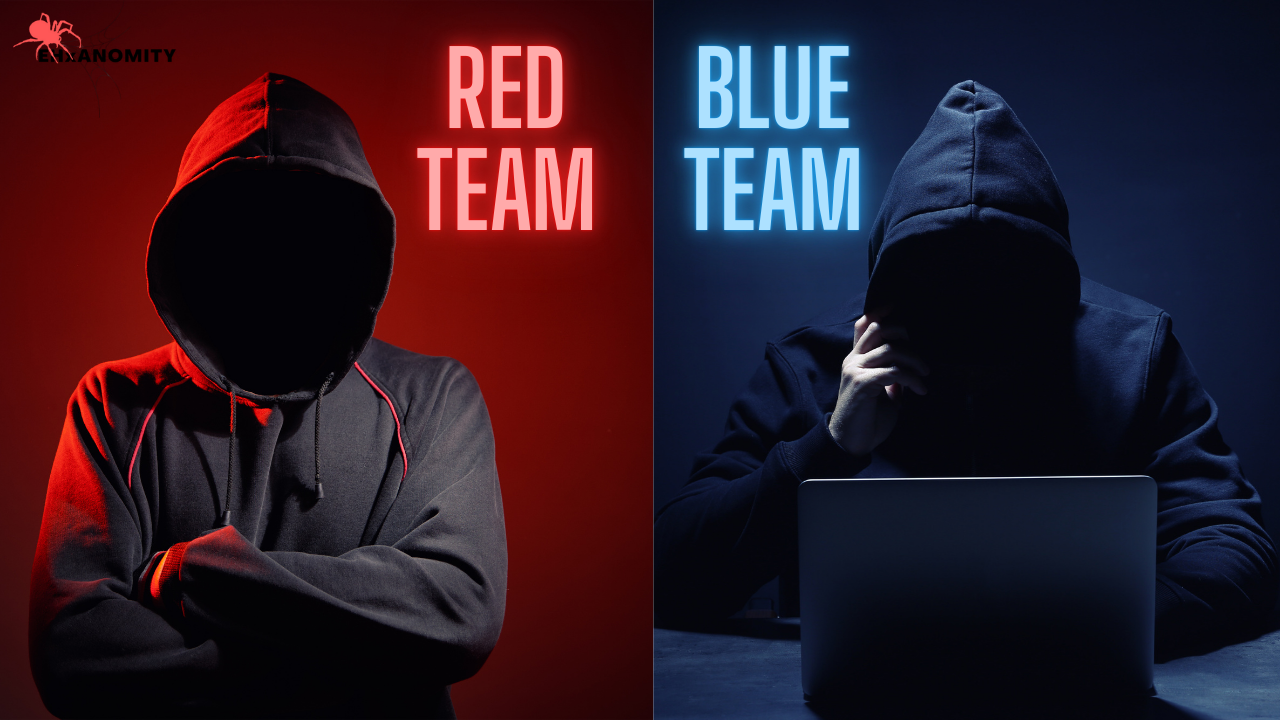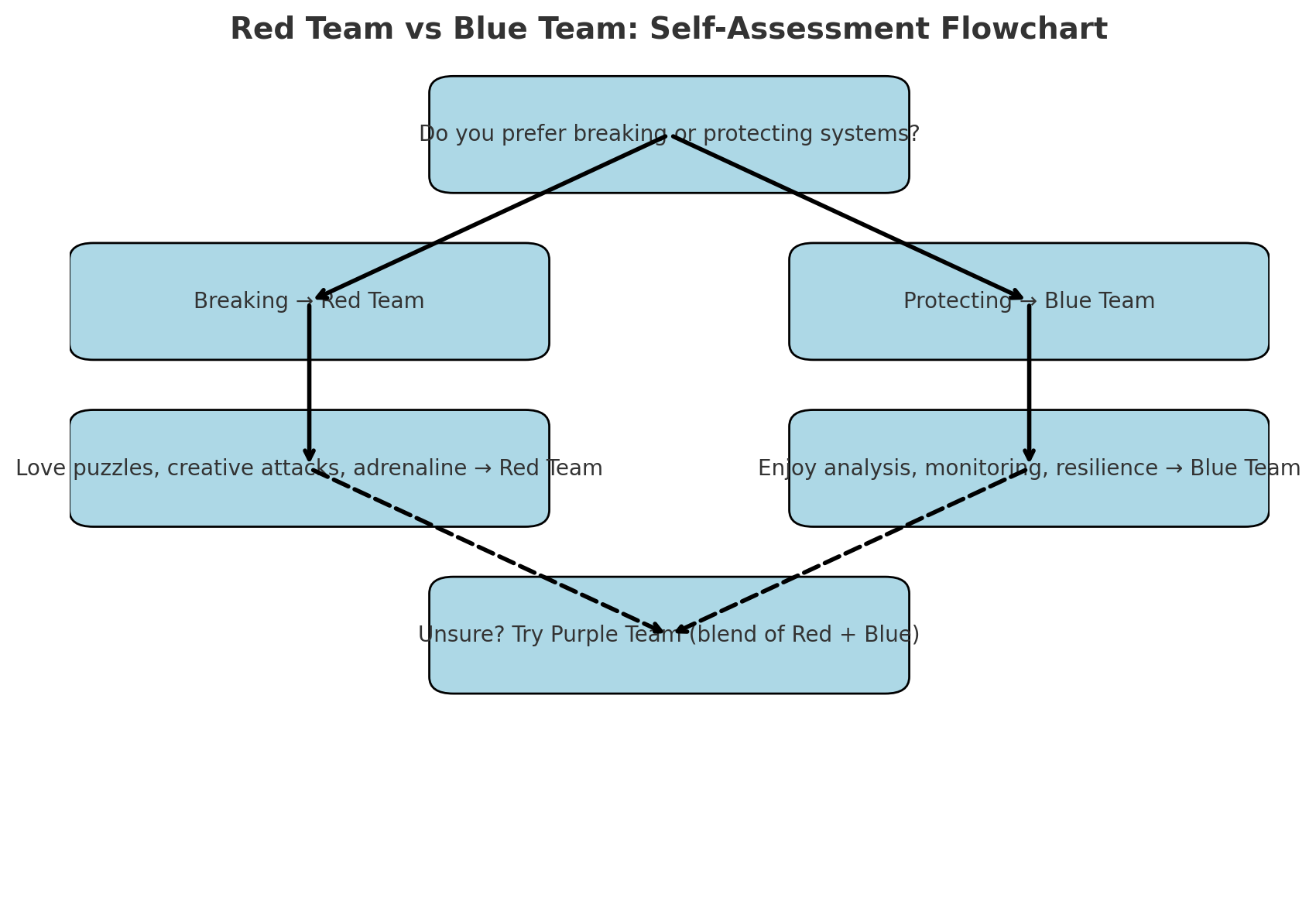Red Team vs Blue Team: Which Cybersecurity Path Is Right for You?
Red Team vs Blue Team in cybersecurity: Which career path is right for you? Discover skills, salaries, tools & real-world insights to choose your future

The Cybersecurity Battlefield
In the world of cybersecurity, the constant tug-of-war between attackers and defenders defines the landscape. On one side, red teams simulate real-world attackers, probing systems for weaknesses. On the other, blue teams fortify defenses, detect intrusions, and keep businesses resilient against an evolving threat environment.
If you’re considering a career in cybersecurity, one of the earliest—and most important—decisions you’ll face is whether to pursue the offensive (red) path or the defensive (blue) path. Both are critical, both are rewarding, and both require different mindsets, skills, and career approaches.
But which one is right for you? This guide will help you answer that question. Drawing on more than a decade of real-world red and blue team experience, I’ll break down what each side does day to day, what skills you’ll need, where the jobs are, and how to evaluate your fit for either path.
Understanding the Two Sides
What Does a Red Teamer Do?
A red team is the “offensive” unit in cybersecurity. Their primary job: think and act like a hacker.
Key responsibilities:
- Conduct penetration testing (apps, networks, cloud, wireless, APIs, IoT)
- Exploit misconfigurations and vulnerabilities
- Perform social engineering and phishing campaigns
- Simulate advanced persistent threats (APTs)
- Report findings and recommend remediation steps
Day-to-day activities might include:
- Running recon on a target using tools like Nmap, Shodan, or Maltego
- Writing and tweaking exploits in Python, PowerShell, or Bash
- Evading detection systems (bypassing EDR, SIEM, IDS/IPS)
- Pivoting through networks using Cobalt Strike, Metasploit, or Sliver
- Crafting phishing emails with payloads for an internal test
Red teamers are judged not just on whether they “break in” but also on how realistically they emulate real-world attackers and how effectively they communicate findings back to defenders.

What Does a Blue Teamer Do?
A blue team is the “defensive” counterpart. Their mission: protect, detect, and respond.
Key responsibilities:
- Monitor and analyze security events (logs, alerts, network traffic)
- Investigate suspicious activity and perform incident response
- Harden systems, networks, and cloud environments
- Develop detection rules and playbooks
- Conduct threat hunting and digital forensics
Day-to-day activities might include:
- Monitoring alerts in SIEM tools like Splunk, ELK, or Microsoft Sentinel
- Responding to malware infections or phishing incidents
- Tuning detection rules to reduce false positives
- Running tabletop exercises or purple team drills
- Applying patches and configuration changes across infrastructure
Blue teamers live in a constant state of vigilance. Their performance is measured by how quickly and effectively they can detect, contain, and recover from threats.
Skills and Mindsets: Red vs Blue
The differences between red and blue aren’t just about tools—they’re about how you think.
Technical Skill Comparison
Red Team:
- Exploitation frameworks: Metasploit, Cobalt Strike, Empire
- Scripting languages: Python, PowerShell, Bash
- Web exploitation (Burp Suite, SQLmap)
- Reverse engineering, exploit development
- Understanding of evasion techniques
Blue Team:
- SIEM platforms: Splunk, ELK, QRadar, Sentinel
- Endpoint detection & response (EDR): CrowdStrike, SentinelOne
- Threat intelligence and malware analysis
- Incident response frameworks (NIST, SANS)
- Cloud security monitoring (AWS GuardDuty, Azure Defender)
Soft Skills & Personality Fit
Red teamers thrive on creativity, curiosity, and persistence. They ask, “What if?” and push boundaries. They need to think like adversaries, adapt quickly, and communicate risks in a non-technical way.
Blue teamers need patience, attention to detail, and a methodical approach. They must be analytical, resilient under pressure, and effective collaborators. Defenders often deal with stress—false alarms, midnight alerts, high-stakes breaches—so composure is key.
Career Progression & Market Outlook
Red Team Career Path
- Entry-level: Junior Penetration Tester, Security Researcher
- Mid-level: Red Team Operator, Senior Pen Tester
- Senior-level: Offensive Security Lead, Exploit Developer, Adversary Emulation Specialist
- Executive-level: Director of Offensive Security, Chief Red Team Strategist
Salary range (India): ₹6–25 LPA
Salary range (US/Europe): $80,000–$160,000+
Market outlook: Demand is strong, but entry is competitive. Many companies hire pen testers before investing in full red teams.
Blue Team Career Path
- Entry-level: SOC Analyst, Security Engineer
- Mid-level: Incident Responder, Threat Hunter, DFIR Specialist
- Senior-level: Blue Team Lead, Security Architect, Detection Engineer
- Executive-level: Director of Security Operations, CISO
Salary range (India): ₹5–30 LPA
Salary range (US/Europe): $75,000–$180,000+
Market outlook: Blue team roles are more abundant. With rising regulations (GDPR, CCPA, DORA) and ransomware threats, every organization needs defenders.
Self-Assessment: Which Side Fits You?
Ask yourself:
- Do I enjoy building or breaking?
- Breaking → Red
- Protecting → Blue
- How do I handle stress?
- Thrive in short bursts of adrenaline and puzzle-solving → Red
- Steady under constant pressure and monitoring → Blue
- What motivates me?
- Outsmarting systems → Red
- Keeping organizations safe and resilient → Blue
- Do I prefer depth or breadth?
- Red often requires going deep into niche vulnerabilities
- Blue demands broad knowledge of systems, networks, cloud, and people
Getting Started: Certifications, Learning, and Resources
Red Team Entry Points
- Certifications: OSCP, eJPT, CRTO, CEH (entry-level, though less respected)
- Labs & Practice: HackTheBox, TryHackMe, PortSwigger Academy
- Programming: Python, PowerShell, C, Bash
Blue Team Entry Points
- Certifications: CompTIA Security+, Splunk Core Certified, GCIH, GCIA, Azure Security Engineer
- Labs & Practice: Blue Team Labs Online, CyberDefenders, DetectionLab
- Skills: Log analysis, digital forensics, threat hunting
Pro tip: If you’re unsure, try purple teaming (a blend of red and blue), which gives you exposure to both offensive and defensive workflows.
Real-World Scenarios: How the Two Differ
- Scenario 1: Phishing Campaign
- Red: Craft a realistic phishing email, test payload delivery.
- Blue: Detect the email, block it, train employees, analyze compromised accounts.
- Scenario 2: Ransomware Simulation
- Red: Gain initial access, drop simulated ransomware payload.
- Blue: Detect lateral movement, isolate infected systems, recover from backups.
- Scenario 3: Cloud Security Breach
- Red: Exploit misconfigured S3 bucket or IAM role.
- Blue: Monitor GuardDuty alerts, enforce least privilege, remediate misconfigurations.
Transitioning Between Red and Blue
Many professionals switch sides at some point:
- Red → Blue: Brings attacker mindset to improve defenses.
- Blue → Red: Uses detection/response knowledge to simulate realistic attacks.
Transitioning is common and valued—cross-trained professionals often move into purple team, detection engineering, or leadership roles.
Industry Trends & Future Outlook
- AI & Automation: Attackers use AI for phishing and malware obfuscation; defenders use AI for threat detection and triage.
- Cloud & DevSecOps: Both red and blue must adapt to cloud-native and containerized environments.
- Regulatory Compliance: Increasingly favors blue team growth.
- Bug Bounty Programs: Offer red teamers freelance opportunities.
Practical Takeaways
- If you love puzzles, creativity, and offense → Start red.
- If you enjoy analysis, protection, and long-term resilience → Start blue.
- Don’t feel locked in—cross-training is common and valued.
- Build a lab at home: Try breaking (red) and defending (blue) the same system.
- Start small—SOC analyst or junior pen tester roles are realistic entry points.
Conclusion: Choosing Your Path
Choosing between red team and blue team isn’t about right or wrong—it’s about fit. The best cybersecurity professionals I’ve mentored are the ones who align their natural mindset with their work: creatives who thrive on offense, analytical thinkers who excel at defense.
But here’s the secret: the industry needs both. Without red teams, defenders grow complacent. Without blue teams, attacks go unchecked. Whichever path you choose, you’ll be on the front lines of one of the most critical challenges of our digital age.
Your first step is simple: try both. Spin up a vulnerable VM, launch an attack, then try to detect it. Notice what excites you more—breaking in, or defending the line. That spark will tell you where you belong.
